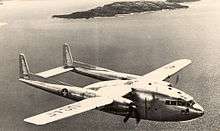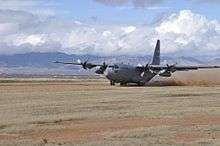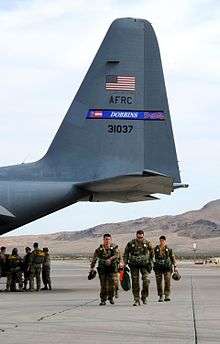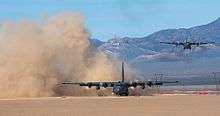700th Airlift Squadron
| 700th Airlift Squadron | |
|---|---|
 B-24H Liberator 42-7563, "Hell's Warrior" showing the 445th Bombardment Group's Circle F tail marking. Aircraft was lost on 9 February 1944 | |
| Active | 1943-1945; 1947-1949; 1952–present |
| Country |
|
| Branch |
|
| Role | Airlift |
| Part of | Air Force Reserve Command |
| Garrison/HQ | Dobbins Air Reserve Base, Georgia |
| Engagements | European Theater of Operations[1] |
| Decorations |
Distinguished Unit Citation Air Force Outstanding Unit Award French Croix de Guerre with Palm Republic of Vietnam Gallantry Cross with Palm[1] |
| Insignia | |
| 700th Airlift Squadron emblem (approved 13 December 1973)[1] |
 |
| 700th Bombardment Squadron emblem (approved 24 August 1944)[2] |
 |
| World War II Fuselage Code[3] | IS |
The 700th Airlift Squadron is part of the 94th Airlift Wing at Dobbins Air Reserve Base, Georgia. It operates C-130 Hercules aircraft providing global airlift.
Mission
Maintain combat ready aircrews and aircraft capable of deploying in response to worldwide contingencies and emergencies.
History
World War II
The 700th Bombardment Squadron was activated 1 April 1943 at Gowen Field in Idaho, where initial organization took place while key personnel traveled to Orlando AAB, Florida for training with the Army Air Forces School of Applied Tactics.[4][2] Both elements met at Wendover Army Air Field, Utah on 8 June 1943, where initial training with the Consolidated B-24 Liberator took place. The squadron moved to Sioux City Army Air Base, Iowa in July 1943 to complete training. In September the squadron began to receive B-24H aircraft, the model of the Liberator they would fly in combat.[4]
On 20 October 1943 the ground echelon moved to Camp Shanks, New York and embarked on the RMS Queen Mary on 26 October 1943, sailing next day. The unit arrived in the Firth of Clyde, Scotland on 2 November 1943 and disembarked at Gourock. The air echelon departed Sioux City late in October 1943 and flew to the United Kingdom via the southern route: Florida, Puerto Rico, Brazil, and West Africa.[5] Upon arrival, the squadron was stationed at RAF Tibenham as part of the 2nd Combat Bombardment Wing.[6] The group was initially given a fuselage code of IS.[3]

The 700th entered combat on 13 December 1943 by attacking U-boat installations at Kiel.[7] The unit operated primarily as a strategic bombardment organization until the war ended, striking such targets as industries in Osnabrück, synthetic oil plants in Lutzendorf, chemical works in Ludwigshafen, marshalling yards at Hamm, an airfield at Munich, an ammunition plant at Duneberg, underground oil storage facilities at Ehmen, and factories at Münster.[8]
The squadron participated in the Allied campaign against the German aircraft industry during Big Week, from 20 to 25 February 1944, being awarded a Distinguished Unit Citation for attacking a Me 110 aircraft assembly plant at Gotha on 24 February.[8] This was the longest running continuous air battle of World War II - some two and a half hours of fighter attacks and flak en route and leaving the target area.[9] Bomb damage assessment photographs showed that the plant was knocked out of production indefinitely.[10]
The unit occasionally flew air interdiction and air support missions. It helped to prepare for the invasion of Normandy by bombing airfields, V-1 and V-2 launch sites, and other targets. It attacked shore installations on D-Day, 6 June 1944,[11] and supported ground forces at Saint-Lô by striking enemy defenses in July 1944. During the Battle of the Bulge, between December 1944 and January 1945 it bombed German communications. Early on 24 March 1945 the 700th dropped food, medical supplies, and ammunition to troops that landed near Wesel during the airborne assault across the Rhine and that afternoon flew a bombing mission to the same area, hitting a landing ground at Stormede.[8]
On occasion the unit dropped propaganda leaflets and hauled fuel to France. It was awarded the Croix de guerre with Palm by the French government for operations in the theater from December 1943 to February 1945[8] supplying the resistance.
By far, the 700th's most tragic mission is the attack on Kassel[12] of 27 September 1944. In cloud, the navigator of the lead bomber of the 445th Bombardment Group miscalculated and the 35 planes of the 700th and the other squadrons of the group left the bomber stream of the 2d Air Division and proceeded to Göttingen some 35 miles (56 km) from the primary target. After the bomb run, the group was alone in the skies and was attacked from the rear by an estimated 150 Luftwaffe planes, resulting in the most concentrated air battle in history. The Luftwaffe unit was a Sturmgruppe, a special unit intended to attack bombers by flying in tight formations of up to ten fighters in line abreast. This was intended to break the bomber formation at a single pass. The 361st Fighter Group intervened, preventing complete destruction of the group. Twenty-nine German and 25 American planes went down in a 15-mile (24 km) radius. Only four of the 445th group's planes made it back to the base – two crashing in France, one in Belgium, another at RAF Old Buckenham.[12] Two landed at RAF Manston. Only one of the 35 attacking aircraft was fit to fly next day.[13]
After the end of the air war in Europe, the 700th flew low level Trolley missions over Germany carrying ground personnel so they could see the result of their efforts during the war.[14] The group's air echelon departed Tibenham on 17 May 1945, and left the United Kingdom on 20 May 1945. The 700th ground echelon sailed on the USAT Cristobal from Bristol.[14] The ship arrived at New York on 8 June 1945. Personnel were given 30 days R&R. The squadron reestablished at Fort Dix, New Jersey, with the exception of the air echelon, which had flown to Sioux Falls Army Air Field, South Dakota. Most personnel were discharged or transferred to other units, and only a handful were left[14] when the unit was inactivated on 12 September 1945.[8]
Cold War
The 700th Bombardment Squadron was activated again in the Reserve during the summer of 1947 at McChord Field, Washington as a Boeing B-29 Superfortress very heavy bombardment squadron.[2] After conducting training for two years, the squadron was inactivated in June 1949[2] when Continental Air Command reorganized to the wing base organizational model. It was replaced at McChord by elements of the 302d Troop Carrier Wing.[15]
The squadron was activated again in the reserves in 1952 at Buffalo Municipal Airport, New York as the 700th Fighter-Bomber Squadron. Although designated as a fighter unit, until 1955 the squadron primarily flew North American T-6 aircraft,[16] although it was equipped with a few North American F-51 Mustangs and Lockheed F-80 Shooting Stars. In 1955 the 700th moved a few miles to Niagara Falls Municipal Airport as a Republic F-84 Thunderjet unit.[2] In 1957 the United States Air Force realigned its reserve forces, transferring all fighter aircraft to the Air National Guard, while Air Force Reserve organizations flew tactical airlift aircraft. As a result, the 700th redesignated as the 700th Troop Carrier Squadron in September and began training in Fairchild C-119 Flying Boxcar aircraft. In mid-November 1957 the 700th squadron's mission, personnel and equipment were transferred to the 64th Troop Carrier Squadron,[17] and the squadron moved on paper to Dobbins AFB, Georgia, where it was attached directly to the 445th Troop Carrier Wing.[2][16] Simultaneously, the 445th group moved to Memphis Municipal Airport[18] When Continental Air Command reorganized under the dual deputy system in November the squadron transferred directly to the wing.[16]

Since 1957, the 700th has provided tactical airlift to include airdrop, airland, and air evacuation of personnel and equipment. It was called to active duty in 1962 during the Cuban Missile Crisis and in 1968 during the Pueblo crisis, although in both cases it remained at its home station. The squadron assisted with the redeployment of U.S. Army and Marine Corps personnel from Grenada following Operation Urgent Fury in 1983. In 1984 and 1985, the squadron helped deploy U.S. personnel throughout Central and South America from Howard Air Force Base, Panama in support of Operations Volant Oak and Coronet Oak.

Current

During the 1990s, the 700th helped deploy U.S. forces to Saudi Arabia in support of Operation Desert Shield. If flew in support of Operation Provide Promise and Operation Provide Comfort II. During the 2000's the 700th transitioned into a school house training future C-130 co-pilots and Aircraft Commanders. In 2011 the 700th made a full transition back to a combat coded unit and has flown several deployments in support of Operation Inherent Resolve and Operation Enduring Freedom.

Operations
Lineage
- Constituted as the 700th Bombardment Squadron (Heavy) on 20 March 1943
- Activated on 1 April 1943
- Redesignated 700th Bombardment Squadron, Heavy 20 August 1943
- Inactivated on 12 September 1945
- Redesignated 700th Bombardment Squadron, Very Heavy and allotted to the reserve on 13 May 1947
- Activated on 12 July 1947
- Inactivated on 27 June 1949
- Redesignated 700th Fighter-Bomber Squadron on 24 June 1952
- Activated on 8 July 1952
- Redesignated 700th Troop Carrier Squadron, Medium on 6 September 1957
- Redesignated 700th Troop Carrier Squadron, Assault on 25 September 1958 (on active service from 28 October 1962 to 28 November 1962)
- Redesignated 700th Troop Carrier Squadron, Heavy on 8 July 1965
- Redesignated 700th Air Transport Squadron, Heavy on 1 December 1965
- Redesignated 700th Military Airlift Squadron on 1 January 1966 (on active service from 26 January 1968 to 2 June 1969)
- Redesignated 700th Tactical Airlift Squadron on 1 April 1972
- Redesignated 700th Airlift Squadron on 1 February 1992[1]
Assignments
- 445th Bombardment Group: 1 April 1943 – 12 September 1945
- 445th Bombardment Group: 12 July 1947 – 27 June 1949
- 445th Fighter-Bomber Group (later 445th Troop Carrier Group: 8 July 1952 (attached to 445th Troop Carrier Wing after 16 November 1957)
- 445th Troop Carrier Wing: 25 September 1958
- 918th Troop Carrier Group (later 918th Air Transport Group, 918th Military Airlift Group, 918th Tactical Airlift Group): 11 February 1963
- 94th Airlift Wing: 1 September 1975
- 94th Operations Group: 1 August 1992 – Present[1]
Stations
- Gowen Field, Idaho, 1 April 1943
- Wendover Field, Utah, 8 June 1943
- Sioux City Army Air Base, Iowa, 8 July 1943 – 20 October 1943
- RAF Tibenham (Station 124),[19] England, 2 November 1943 – 30 May 1945
- Fort Dix Army Air Base, New Jersey, 9 June 1945 – 12 September 1945
- McChord Air Force Base, Washington, 12 July 1947 – 27 June 1949
- Buffalo Municipal Airport, New York, 8 July 1952
- Niagara Falls Municipal Airport, New York, 15 June 1955
- Dobbins Air Force Base (later Dobbins Air Reserve Base), Georgia, 16 November 1957 – Present[1]
Aircraft
- B-24 Liberator (1943–1945)
- T-6 Texan (1952–1955)
- P-51 Mustang (1953–1954)
- F-80 Shooting Star (1953–1956)
- F-84 Thunderjet (1954–1957)
- C-119 Flying Boxcar (1957–1958)
- C-123 Provider (1957–1965)
- C-124 Globemaster II (1965–1972)
- C-7 Caribou (1972–1982)
- C-130 Hercules (1982 – Present)[1]
References
Notes
- 1 2 3 4 5 6 7 Robertson, Patsy (August 23, 2010). "Factsheet 700 Airlift Squadron (AFRC)". Air Force Historical Research Agency. Retrieved September 17, 2018.
- 1 2 3 4 5 6 Maurer, Combat Squadrons, pp. 706–707
- 1 2 Watkins, pp. 88–89
- 1 2 Birsic, pp. 11–12
- ↑ Birsic, pp. 14, 17
- ↑ Birsic, p. 15
- ↑ Birsic, p. 21
- 1 2 3 4 5 Maurer, Combat Units, pp. 319–320
- ↑ Birsic, p. 45 (Citation for Distinguished Unit Citation)
- ↑ Birsic, p. 24
- ↑ Birsic, p. 29
- 1 2 Giesler, Duane. "The Kassel Mission Historical Society: Dedicated to the 445th Bomb Group". The Kassel Mission Historical Society. Archived from the original on 10 May 2017. Retrieved 17 September 2018.
- ↑ Birsic, pp. 33-34
- 1 2 3 Birsic, p. 42
- ↑ See Mueller, pp. 391–396
- 1 2 3 Ravenstein, pp. 241–242
- ↑ Maurer, Combat Squadrons, p. 245
- ↑ Haulman, Daniel (August 9, 2017). "Factsheet 445 Operations Group (AFRC)". Air Force Historical Research Agency. Retrieved September 17, 2018.
- ↑ Station number in Anderson.
Bibliography
![]()
- Anderson, Capt. Barry (1985). Army Air Forces Stations: A Guide to the Stations Where U.S. Army Air Forces Personnel Served in the United Kingdom During World War II (PDF). Maxwell AFB, AL: Research Division, USAF Historical Research Center. Archived from the original (PDF) on 4 March 2016. Retrieved 7 July 2012.
- Birsic, Rudolph J. (1947). The History of the 445th Bombardment Group (H) (unofficial). Bangor Public Library World War II Regimental Histories. No. 98. Glendale, CA: Griffin-Patterson Co. ISBN 978-0-9845301-0-6. Retrieved 15 August 2013. (ISBN is for 2010 reprint. Original has no page numbers, pages from online .pdf of original)
- Maurer, Maurer, ed. (1982) [1969]. Combat Squadrons of the Air Force, World War II (PDF) (reprint ed.). Washington, DC: Office of Air Force History. ISBN 0-405-12194-6. LCCN 70605402. OCLC 72556.
- Maurer, Maurer, ed. (1983) [1961]. Air Force Combat Units of World War II (PDF) (reprint ed.). Washington, DC: Office of Air Force History. ISBN 0-912799-02-1. LCCN 61060979.
- Mueller, Robert (1989). Air Force Bases, Vol. I, Active Air Force Bases Within the United States of America on 17 September 1982 (PDF). Washington, DC: Office of Air Force History. ISBN 0-912799-53-6.
- Ravenstein, Charles A. (1984). Air Force Combat Wings, Lineage & Honors Histories 1947-1977 (PDF). Washington, DC: Office of Air Force History. ISBN 0-912799-12-9.
- Watkins, Robert (2008). Battle Colors: Insignia and Markings of the Eighth Air Force In World War II. Vol I (VIII) Bomber Command. Atglen, PA: Shiffer Publishing Ltd. ISBN 0-7643-1987-6.
